|
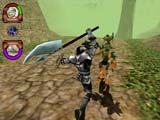 Crusaders
of Might and Magic probably sounded like a good idea at one time. Why not
use the incredibly rich background of the ultra-successful Might and Magic
franchise to create a 3rd-person RPG/Action game? Just imagine
a Lara Croft type-heroine leveling up while fighting her way through the
perils of Erathia. Sound good? Sounds damn good.
Unfortunately, Crusaders of Might and Magic is not that game.
Unbelievably, 3DO has squandered the good name of its most popular
franchise on a game that is utterly devoid of excitement, charm, or wit.
Though it tries to be an action game and an RPG, it fails at both. Even
worse, it avails itself not at all of the Might and Magic mythos—if 3DO
had left out the Might and Magic in the title, you’d never make the
connection between the series and this game. Crusaders
of Might and Magic probably sounded like a good idea at one time. Why not
use the incredibly rich background of the ultra-successful Might and Magic
franchise to create a 3rd-person RPG/Action game? Just imagine
a Lara Croft type-heroine leveling up while fighting her way through the
perils of Erathia. Sound good? Sounds damn good.
Unfortunately, Crusaders of Might and Magic is not that game.
Unbelievably, 3DO has squandered the good name of its most popular
franchise on a game that is utterly devoid of excitement, charm, or wit.
Though it tries to be an action game and an RPG, it fails at both. Even
worse, it avails itself not at all of the Might and Magic mythos—if 3DO
had left out the Might and Magic in the title, you’d never make the
connection between the series and this game.
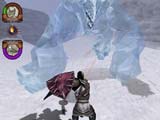 As
an action game, CoMM fails through its incredible repetitiveness. Here’s
the game in a nutshell—someone tells you to get something. You go find
it by running down long corridors (it doesn’t matter what the setting
is—woods, glaciers, mines, catacombs—everything is a corridor). Every so often in these corridors you’ll see two or three
bad guys long before they see you. You cast a spell, attack them, kill
them all, and pick up their stuff. Then you run down the corridor some
more until you see more bad guys. Rinse and repeat. I’m serious, this is
at least 95% of the game, and it becomes tiresome long before this very
short game nears its anticlimactic conclusion. And not only is the basic
gameplay repetitive, but so are the game’s quests. For example, in one
you’ll run through a long corridor-like cavernous area killing
everything, then through another long corridor-like wooded area killing
everything. Finally, you reach your goal, where you are told to run
through a long corridor-like mine area killing everything. After achieving
your quest, you get to go home—you guessed it—by running through the
same wooded and cavernous areas (now repopulated with monsters) that you
just came from. Incredibly, after your arrival at home you’re given
another quest that requires you to traverse these exact same areas again. As
an action game, CoMM fails through its incredible repetitiveness. Here’s
the game in a nutshell—someone tells you to get something. You go find
it by running down long corridors (it doesn’t matter what the setting
is—woods, glaciers, mines, catacombs—everything is a corridor). Every so often in these corridors you’ll see two or three
bad guys long before they see you. You cast a spell, attack them, kill
them all, and pick up their stuff. Then you run down the corridor some
more until you see more bad guys. Rinse and repeat. I’m serious, this is
at least 95% of the game, and it becomes tiresome long before this very
short game nears its anticlimactic conclusion. And not only is the basic
gameplay repetitive, but so are the game’s quests. For example, in one
you’ll run through a long corridor-like cavernous area killing
everything, then through another long corridor-like wooded area killing
everything. Finally, you reach your goal, where you are told to run
through a long corridor-like mine area killing everything. After achieving
your quest, you get to go home—you guessed it—by running through the
same wooded and cavernous areas (now repopulated with monsters) that you
just came from. Incredibly, after your arrival at home you’re given
another quest that requires you to traverse these exact same areas again.
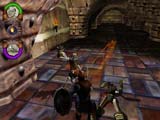 The
game’s RPG element is, if anything, even more disappointing.
Though your character Drake—an annoyingly unoriginal hero of the
smartass/ cynic variety—can level up, you’re never quite sure what’s
gained by doing so. There’s much fanfare when you level up, including a
dramatic frozen screen and clarion call, which means it must be
significant, but you’re not allowed to allocate experience or develop
skills or well, anything. Your
combat skills thus remain strangely static—you’ll never develop new
attacks or abilities, you just sort of get better at them, I suppose,
though there’s no real evidence of this either. The game’s magic
system is little better. CoMM has ten different spells, each with three
levels of effectiveness. You improve these by finding scrolls, which
usually means by scrutinizing the inventory of every monster you kill.
This is tedious, but then this game is a monument to tedium, so at least
it’s consistent. As with the combat system, you’re never quite sure
how much your skills improve from level to level.
And of course one of the true joys of RPGs is, as my wife says,
shopping. There’s nothing like garnering just enough gold coin to buy
the King’s Sword or Banded Armor that will allow you to work through a
previously unassailable level. Unfortunately, there’s scarcely any
shopping in CoMM. Though you’ll collect loads of gold from the monsters
you defeat, there are very few places to buy anything, and even less stuff
to buy. In a world with like three or four stores, you’ve got to wonder
why everyone’s running around with so much gold in their pockets. And once you get to a shop, you’ll find very little variety
of weapons and armor. You’ll see the same sets and weapons over and
over, so there’s not much point in collecting gold, especially since
you’ll be able to pick up some of these weapons and swords from fallen
enemies. Even if you do choose to buy an item, you’re given no
information about its attributes before you buy it. You can, however, buy
something, try it on, see what it does to your attributes, and then sell
it back for the same price. Gah. Likewise, if you need to buy some health,
you’ll often find that the shop only has one potion in stock. Need more?
No problem, all you gotta do is duck out of the shop and return.
There’ll be another one in stock. Need another? Rinse and repeat. The
game’s RPG element is, if anything, even more disappointing.
Though your character Drake—an annoyingly unoriginal hero of the
smartass/ cynic variety—can level up, you’re never quite sure what’s
gained by doing so. There’s much fanfare when you level up, including a
dramatic frozen screen and clarion call, which means it must be
significant, but you’re not allowed to allocate experience or develop
skills or well, anything. Your
combat skills thus remain strangely static—you’ll never develop new
attacks or abilities, you just sort of get better at them, I suppose,
though there’s no real evidence of this either. The game’s magic
system is little better. CoMM has ten different spells, each with three
levels of effectiveness. You improve these by finding scrolls, which
usually means by scrutinizing the inventory of every monster you kill.
This is tedious, but then this game is a monument to tedium, so at least
it’s consistent. As with the combat system, you’re never quite sure
how much your skills improve from level to level.
And of course one of the true joys of RPGs is, as my wife says,
shopping. There’s nothing like garnering just enough gold coin to buy
the King’s Sword or Banded Armor that will allow you to work through a
previously unassailable level. Unfortunately, there’s scarcely any
shopping in CoMM. Though you’ll collect loads of gold from the monsters
you defeat, there are very few places to buy anything, and even less stuff
to buy. In a world with like three or four stores, you’ve got to wonder
why everyone’s running around with so much gold in their pockets. And once you get to a shop, you’ll find very little variety
of weapons and armor. You’ll see the same sets and weapons over and
over, so there’s not much point in collecting gold, especially since
you’ll be able to pick up some of these weapons and swords from fallen
enemies. Even if you do choose to buy an item, you’re given no
information about its attributes before you buy it. You can, however, buy
something, try it on, see what it does to your attributes, and then sell
it back for the same price. Gah. Likewise, if you need to buy some health,
you’ll often find that the shop only has one potion in stock. Need more?
No problem, all you gotta do is duck out of the shop and return.
There’ll be another one in stock. Need another? Rinse and repeat.
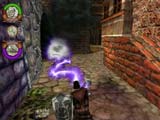 Graphically,
CoMM is not bad, but the spectre of repetitiveness that haunts the rest of
the game also manifests itself in its graphics. Each area has its own
look, but that look never varies much within the area, and as with
everything else in this game, it quickly becomes tiresome. Same thing with
the game’s monsters—you’ll experience two or three different types
in each area, and that’s it. This is remarkable, especially considering
the game’s putative Might and Magic pedigree. Where are the legions of
different monster types found in M&M or HoMM? They ain’t here. On
the up side, spell effects are cool, but the game has some major clipping
problems. You’ll often find yourself fighting monsters whose bodies are
partially encased in walls. And the less said of the sound, the better;
effects are OK, but voice acting is just awful. It sounds like they just
went around the office asking people to read lines the day after they’d
engaged in a particularly terrible bender. Graphically,
CoMM is not bad, but the spectre of repetitiveness that haunts the rest of
the game also manifests itself in its graphics. Each area has its own
look, but that look never varies much within the area, and as with
everything else in this game, it quickly becomes tiresome. Same thing with
the game’s monsters—you’ll experience two or three different types
in each area, and that’s it. This is remarkable, especially considering
the game’s putative Might and Magic pedigree. Where are the legions of
different monster types found in M&M or HoMM? They ain’t here. On
the up side, spell effects are cool, but the game has some major clipping
problems. You’ll often find yourself fighting monsters whose bodies are
partially encased in walls. And the less said of the sound, the better;
effects are OK, but voice acting is just awful. It sounds like they just
went around the office asking people to read lines the day after they’d
engaged in a particularly terrible bender.
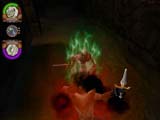 As
far as interface and controls go, the movement and combat controls are
quite good, actually the best part of the game, and camera angles shift
very smoothly. Likewise, you’re given plenty of movement and attack
options—though you’ll probably not need to use any of them. One odd
thing—though the game quite effectively uses the mouse and keyboard
controls most often associated with first person shooters, its default
controls do not follow the typical “Quake” WAD configuration, but
rather ESF. Why, I dunno, but those of you who’ve been playing UT or
QIII will screw up plenty if you pick up this game. But for all the
controls’ virtues, they do have some problems. For some reason, items
left on the ground can be very difficult to pick up. Although the
“tab” key is supposed to do this, you’ll often find yourself
switching to your inventory screen to move items into your inventory.
Since virtually every one of the endless hordes of enemies will leave
something on the ground, this gets old in a hurry, too.
And though you’re given a map and a quest log, I found the map to
be useless—it merely tells you what area you’re in, and offers only
the broadest of hints as to how to get from place to another. As for the
quest log, well, mine seemed to be broken; though a notes section is
supposed to record important moments in the game, mine got stuck on the
first quest and never updated. As
far as interface and controls go, the movement and combat controls are
quite good, actually the best part of the game, and camera angles shift
very smoothly. Likewise, you’re given plenty of movement and attack
options—though you’ll probably not need to use any of them. One odd
thing—though the game quite effectively uses the mouse and keyboard
controls most often associated with first person shooters, its default
controls do not follow the typical “Quake” WAD configuration, but
rather ESF. Why, I dunno, but those of you who’ve been playing UT or
QIII will screw up plenty if you pick up this game. But for all the
controls’ virtues, they do have some problems. For some reason, items
left on the ground can be very difficult to pick up. Although the
“tab” key is supposed to do this, you’ll often find yourself
switching to your inventory screen to move items into your inventory.
Since virtually every one of the endless hordes of enemies will leave
something on the ground, this gets old in a hurry, too.
And though you’re given a map and a quest log, I found the map to
be useless—it merely tells you what area you’re in, and offers only
the broadest of hints as to how to get from place to another. As for the
quest log, well, mine seemed to be broken; though a notes section is
supposed to record important moments in the game, mine got stuck on the
first quest and never updated.
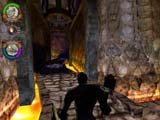 Finally,
the game has no story, or at least an underdeveloped one. You’ll snap to
what’s going on almost immediately, and I can guarantee that whatever
conjecture you come up with will be more intriguing than the game’s
actual plot. There’s no payoff for most quests; you just sort of
abruptly go on to another. It almost seems like there were supposed to be
cutscenes to advance the plot in certain places, but time or cost
determined that these be left out. Finally,
the game has no story, or at least an underdeveloped one. You’ll snap to
what’s going on almost immediately, and I can guarantee that whatever
conjecture you come up with will be more intriguing than the game’s
actual plot. There’s no payoff for most quests; you just sort of
abruptly go on to another. It almost seems like there were supposed to be
cutscenes to advance the plot in certain places, but time or cost
determined that these be left out.
Frankly, I’m
baffled by this game. Given the overall excellence of the Might and Magic
series and the overall nastiness of this title, I’m surprised it was
even released. It should not have been. Caveat Emptor.
--Rick
Fehrenbacher |
